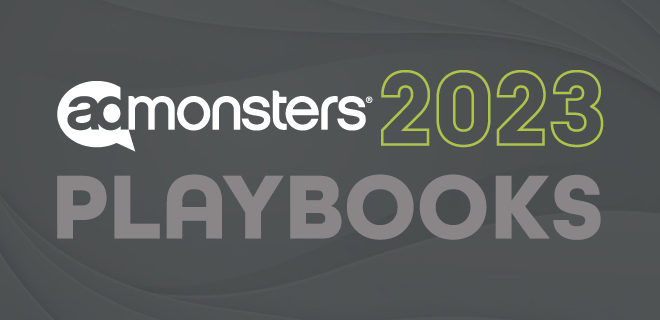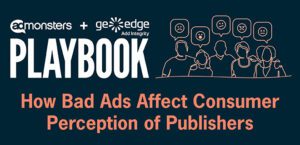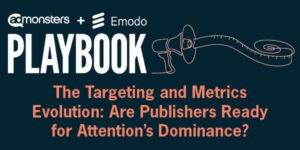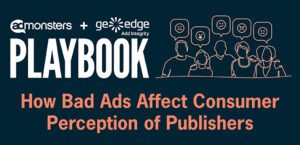
There’s a storm a’ coming. Hurry up and grab your raincoat. Or better yet, get yourself a plan. We’ve got a few that will serve you well.
2023 felt like the beginning of the end. It was like the perfect maelstrom.
A recession was forecasted. Oh no, no it wasn’t. Ad spend was plummeting. Oh wait, it started inching back up again. For publishers, there was just no way to make heads or tails out of the year that was the last before the 3P cookies’ demise.
Political ad spend is on the rise, but there are ad quality challenges for any publisher wanting to jump into that pool. We’ve got a playbook for navigating those waters. Targeting and metrics are getting a remix and creative could use a facelift. We’ve got a playbook to guide you through attention’s dominance.
What about bad ads, are they tarnishing consumers’ perceptions about your media properties? We surveyed 250 consumers to give it to you straight — along with publishers’ tips for cracking down on those bad actors and making the user experience a priority.
And finally, we took a deep dive into how widely contextualized AdOps data shared with sales and ad product teams. The truth is, AdOps teams are rock stars (party on) but sales teams might not be taking full advantage of their data stardom. We’ve got a playbook for that too. All it involves is making meaningful workflow changes to focus on revenue-generating tasks.
You really should download one of these (if not all of them).
AdMonsters Publisher Playbooks of 2023
AdOps Are Rock Stars. Are Sales Teams Taking Advantage of Their Stardom?
 AdOps teams are data superstars, sitting on a treasure trove of information that contains rich and nuanced context. Many can say which ad units perform best, by format, section, industry and vertical. Some can accurately predict the ROAS advertisers can expect to see from their campaigns.
AdOps teams are data superstars, sitting on a treasure trove of information that contains rich and nuanced context. Many can say which ad units perform best, by format, section, industry and vertical. Some can accurately predict the ROAS advertisers can expect to see from their campaigns.
This is the kind of data that attracts advertisers, especially during a recession when their budgets are smaller and all focus is on performance and business outcomes.
But are publishers taking full advantage of these amazing resources? Our survey indicates they are not. There’s not enough collaboration between AdOps and the sales, product, and business intelligence teams. This is caused by a combination of tech limitations and interdepartmental inefficiencies.
More worrisome, only 22% of AdOps teams say they have access to a wealth of data and insights, which means the remaining 78% can’t help their colleagues succeed in their jobs to the fullest possible extent.
Now that advertisers are cutting back on campaigns, publishers need to work harder to attract brands to their sites. Detailed performance data distributed to all the teams that need it can help publishers win more business and revenue. As it stands, they’re leaving money on the table. Download this playbook now!
How Bad Ads Affect Consumer Perception of Publishers
 Publishers have always struggled with bad ads. Nefarious players and scammers, who sought to exploit the digital advertising ecosystem to steal money or data from consumers, have been around almost since the first ad was placed.
Publishers have always struggled with bad ads. Nefarious players and scammers, who sought to exploit the digital advertising ecosystem to steal money or data from consumers, have been around almost since the first ad was placed.
But as the world became more digitized, and as global wealth (and access to it) went online, bad actors stepped up their game. Online scams beginning with a digital ad are now dizzyingly complex, with fraudsters going to great lengths to appear legitimate to their victims.
Not surprisingly, malvertising is now a major crime, with 46% of consumers saying they, or someone they know, has fallen prey to a scam. According to the FBI, American consumers lost $10 billion to online scammers in 2022, and 2023 promises to be an even worse year for consumers.
Malvertising and malware are upending digital advertising, with the FBI warning consumers to install ad blockers, and the New York Times telling its readers that “if it’s advertised, you probably shouldn’t buy it.”
Programmatic advertising burst onto the scene in the mid-2000s promising better monetization opportunities for publishers and better access to audiences for brands. That promise led to a robust industry; in 2022 global revenues topped $173.74 billion worldwide.
The scales have tipped, and programmatic has become more of a liability than an asset. Last year, Bloomberg News made headlines when it announced it was pulling the plug on open programmatic, citing bad ads and the impact they had on the reader’s experience.
They’re hardly alone. Jared Collett, Sr. Director of Ad Operations and Analytics, Major League Fishing, also said his company changed who they work with as a result of bad ads. “We’ve had to sever relationships with various programmatic partners and ad networks because they couldn’t get control over the bad ads they were sending us. I would rather serve a house ad, or no ads than serve a bad ad.”
Worse, bad ads are eroding consumer trust in publishers. For 77% of consumers, a bad ad is a signal that the publisher cares more about making money than it does about their safety. Another 64% say that seeing a bad ad on a single site tarnishes the entire industry. It’s fair to say we’re at a crisis point.
“This finding is really important. It brings home the point that rightly or wrongly, the reputation of the advertiser and the reputation of the publisher are really tied together. This is something media organizations will need to address.” said Amnon Siev, CEO, GeoEdge. Download this playbook now!
Targeting and Metrics Evolution: Are Publishers Ready for Attention’s Dominance?
 Our survey results reveal that 2024 promises to be a year of rapid innovation, with publishers rethinking what’s possible:
Our survey results reveal that 2024 promises to be a year of rapid innovation, with publishers rethinking what’s possible:
The New Metric: Attention. As the digital advertising landscape undergoes transformations that limit the use of traditional identifiers, publishers are adapting their measurement practices to meet their advertising clients’ expectations. Driven by advertising demand, 82% of publishers said that attention metrics, which evaluate the amount of attention a consumer spends with content, are important or very important to their organizations. We see new metrics emerging, and publishers reporting some success, but new tools and education are still required.
Innovative Ad Formats & Ad Placements. Publishers are realizing that there is a significant opportunity to drive higher attention rates by experimenting with new and innovative ad formats (45%) or ad placements (55%), signaling a new era in which the advertising sector turns its focus from innovating in targeting to innovating in creative and placement.
Targeting Capabilities. While cookie-based targeting was mediocre at best, it did enable advertisers to scale their campaigns and develop proxies for their ideal audiences. Today, however, publishers are seeking privacy-compliant ways to home in on receptive audiences. Key among them: leveraging their first-party data.
Indirect Monetization. Some publishers appear open to granting permission for indirect representation of their inventory, allowing marketers to access approved pathways via ads.txt and other sources, even from non-direct partners. To maintain and optimize the list over time, publishers implement monitoring, regular communication, audits, and data analysis. This ensures a strong ecosystem of indirect partners, maximizing monetization while maintaining control and quality assurance. Download this playbook now!
Navigating Political Ads for the 2024 Season
 A staggering $10 billion will pour into the political advertising arena to sway American voters during the 2024 Election cycle. While $10 billion is a boon for digital media stakeholders, that money comes with severe risks.
A staggering $10 billion will pour into the political advertising arena to sway American voters during the 2024 Election cycle. While $10 billion is a boon for digital media stakeholders, that money comes with severe risks.
Navigating misinformation and disinformation will be a key challenge of this election cycle, driven by the widespread availability of sophisticated AI tools. Digital publishers and CTV stakeholders face direct and negative effects on their business, from drops in user engagement to broader societal mistrust.
The proliferation of generative AI, deepfakes, and sophisticated malvertising tactics have empowered fraudsters and foreign governments to distribute deceptive ads via programmatic channels. This alarming trend has forced digital media entities into a rapid and rigorous process of establishing, overhauling, and strictly enforcing political ad quality policies.
Ultimately it falls to publishers to serve as the final bastion of defense for their audiences. Publishers must undertake the critical task of determining whether specific advertisers and promoters of sensitive, hot-button issues can be permitted to run ads on their sites and under which conditions, while simultaneously ensuring malicious actors are kept at bay.
This Playbook provides a robust framework for an ad quality strategy, essential for setting up robust election advertising guidelines. It delves into the tools available to publishers for increased visibility and control, shedding light on challenges in the upcoming election cycle. The Playbook’s goal is to empower publishers to guarantee that political ads on their platforms are informative and accurate and enhance both user experience and their reputation. Download this playbook now!